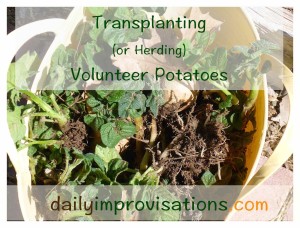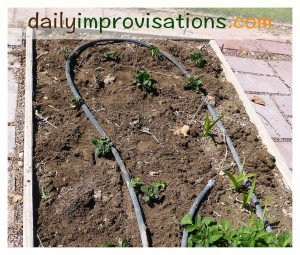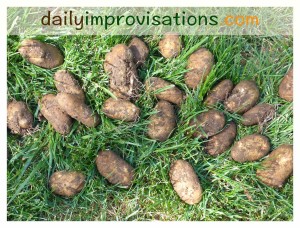
If you have ever grown potatoes, you know that it is nearly impossible to dig up every single one of them at harvest time. If they stay in the ground, many are far enough below ground level that they are not turned to mush by freezing winter temperatures. Thus it is that they sprout readily in the spring.
The good thing about this is that you can get an idea of the optimum time to plant potatoes. The bad thing is that potatoes are difficult to remove from an area where you have something else planted. In fact, potatoes are one of the reasons that I have given up ritualistic crop rotation. (click on any photo to enlarge)
Last year I was both deciding where my potatoes would ultimately call home and how many varieties of potatoes could be planted at the last minute in creative places. Not really complimentary goals, I know. And I am dealing with the fallout this year.
Then, there were other factors, like giving over a whole garden section to chickens and finding a new home for a strawberry patch (the method I used two years ago was working very well, so I would be doing it the same way). Everything was going smoothly with the bare root strawberry plants until rogue potatoes from last year began sprouting around them. Potatoes sprout big, taking over a space the circumference of an orange right from the start and growing hugely after that. They easily crowd out anything else in the area, so my strawberry plants were at risk. I began trying to weed them out.
The problem is that if the potato tuber is left in the ground, it may very well grow again; but pulling it up by the root frequently means creating a tunnel to the surface as a whole potato errupts! This can uproot a more delicate seedling, and was definitely making shock waves for my fledgling strawberry plants, which were just taking root.
There was not one way that was going to work best in every spot. If the budding potato was too close to a strawberry, I had to try to pinch it as far below the soil as I could. This is not easy to do while avoiding strawberry roots, plus the stem-root of the potato is quite thick. It would also required going back soon and often to nip other new growth. More motivation to not always be planting potatoes in new places.
If the emerging potato plant was far enough away to pull, but not far enough away to dig, I still often ended up with a small potato attached to the plant. Some potato volunteers where far enough away from any strawberry plant that I could dig up what appeared to be the whole potato plant. I tossed these two types of potato “weeds” into a pile to collect later.

When I finally came back to clean-up a couple days later, they were all still growing! I decided that was my cue to transplant the best of them into the designated potato raised bed. Based on the success I had with transplanting wrinkled, sprouting potatoes a couple years ago, I knew just how resilient potatoes are.
There were already some other volunteer potatoes in that raised bed, but there was one end that had room for several transplants. I snuck in a few other transplants along one side, realizing that that would make digging potatoes potentially a game of Russian roulette. What is life without a little excitement…
As with all transplants, I made it a point to hold the sprouting potatoes (I don’t think they can be called seedlings!) either by the roots or by the leaves. It was easy enough to plant them at a the correct depth because I could tell how the had been situated previously. As each was placed in a hole, I tamped down the soil around it.

I filled in the chosen area of the raised bed, spacing the potato sprouts about 18 inches apart. This is different than planting them in a row, but will make best use of the space. And keep weeds down. I can always trim back foliage, or support it some way, if it spills out of the raised bed too much.
My husband came to check on me while I was doing all of this. He asked what I was doing. I answered that I was trying to get all the potatoes in one place! He replied, “Ah! Herding potatoes!” And a new garden term was born.
Most of the potatoes that I transplanted this time were red potatoes. There was another raised bed that had volunteer Rubanks in it, which would be trouble for the spinach planted and just sprouted this spring. Many of these potatoes were far enough away from new seedlings that I actually got a harvest of potatoes that we used in a pot pie for dinner that night!


One advantage of Paul Bunyan size of potato sprouts is that I can mulch around them right away without losing them. I did this the same weekend with new grass clippings. A week later, the potato plants look like they have been growing there their whole lives. I have a raised bed full of potato plants without purchasing a single potato for the garden. A very satisfying result to what started out as a weed problem.

Leave a Reply